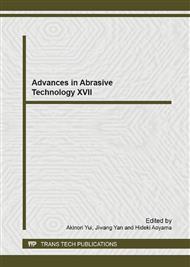p.675
p.681
p.686
p.692
p.696
p.705
p.709
p.715
p.720
Monitoring of Wear Land Width of Diamond Tool Cutting Edge with Large Nose Radius in Ultra-Precision Cutting Using Static Cutting Forces
Abstract:
Large wear of diamond tools for ultra-precision cutting of soft metals deteriorates quality of machined surface, and the worn tools have to be replaced with new tools when the tool wear reaches limited wear land width of cutting edge generating finished surface. However, it is difficult to predict the tool life since all cutting tools have individual tool life. Therefore, the purpose of this study is to estimate wear land width of cutting edge of a single crystal diamond tool having large nose radius by using static cutting forces during machining. As a result of the cutting tests and measurements, it was found that the ratio of thrust force to principal force had good relation with the ratio of flank wear land area to cutting cross section area. Furthermore, according to some detailed observation of flank wear, width of flank wear land was greatly related to uncut chip thickness obtained under different cutting conditions and it was found that width of flank wear land could be estimated by measured static cutting forces and cutting conditions.
Info:
Periodical:
Pages:
696-702
Citation:
Online since:
September 2014
Authors:
Keywords:
Price:
Сopyright:
© 2014 Trans Tech Publications Ltd. All Rights Reserved
Share:
Citation:


